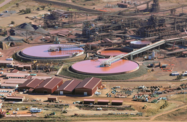Seeking to reduce its dependence on coal-fired power, South Africa is shifting its energy mix toward natural gas and renewables.
The country currently consumes around 180bn standard cu feet (scf) of gas per year and remains heavily reliant on imports to satisfy demand. Roughly two-thirds of total consumption is imported from neighbouring Mozambique.
With the authorities announcing plans to add 3.1 GW of gas-fired generation capacity by 2025, compared to a total of 1.35 GW at present, identifying new domestic gas reserves and boosting imports both rank high on the agenda.
Commercialising conventional reserves
Efforts to commercialise the Ibhubesi gas field, located 105 km off the coast of North Cape Province, have taken another step forward, with Australia’s Sunbird Energy – which holds a 76% stake in the joint venture alongside national oil company PetroSA’s 24% – signing an agreement with public electricity utility Eskom last year.
Ibhubesi ranks as the largest proven gas field in the country, with 540bn scf of deposits and an additional 7.8trn scf believed to lie in the surrounding Orange Basin.
Under the deal, Eskom’s Ankerlig power stations, 40 km north of Capetown, will take delivery of 30bn scf of gas per day for up to 15 years beginning in 2018, when production at Ibhubesi is expected to come on-line.
Exploration efforts are also progressing in nearby Saldanha Bay, where 14 oil and gas exploration licences have been issued for blocks off the coast.
Discovery and drilling in the area could help fuel ongoing development of the nearby industrial development zone (IDZ) specialising in oil and gas services and marine repair.
According to Willem Roux, Saldanha Bay port manager, the IDZ, which is scheduled to see R9.2bn ($602.5m) worth of investment over the next five years, is ideally positioned to serve oil rigs operating off the west and east coasts of Africa; around 120 oil rigs pass by the South Africa coastline each year, he told local media in 2015.
While much of the hub’s capacity will be geared toward supporting offshore production, work is also beginning on a liquefied petroleum gas import terminal in the bay, due to come online by June 2017.
Shale potential
In addition to conventional reserves, shale gas presents an attraction avenue for boosting domestic supply, with South Africa home to the eighth-largest shale reserves in the world.
Numerous energy firms, including Shell, Falcon Oil & Gas and Bundu Gas & Oil, have long sought permission to explore shale gas potential in the Karoo Basin in the south of the country.
The semi-arid Karoo region, which is also home to a national park, is thought to hold between 390trn and 485trn scf of recoverable reserves. According to a study commissioned by Shell, extracting just 50trn scf of these reserves could add up to $20bn per year to South Africa’s economy – equivalent to 0.5 GDP percentage points – for the next 25 years and create as many as 700,000 jobs.
If granted a licence to drill, the company has said it would invest some $200m during the first exploration phase of six planned wells.
In early March, following several years of debate over the environmental impacts of production, the government announced that shale gas exploration would begin within 12 months.
“One area of real opportunity for South Africa is the exploration of shale gas,” a joint statement by cabinet ministers responsible for the economy said in March. “Exploration activities are scheduled to commence in the next financial year. This will lead to excellent prospects for beneficiation and add value to our mineral wealth.”
Water worries
Despite the discovery of commercially viable reserves, extracting the shale gas may not be an easy feat.
According to a recent strategic environmental assessment for shale gas development in South Africa, in order to disrupt the substrata and release the gas, vast amounts of water would be required as part of the fracking process, water the arid Karoo region does not naturally possess. Average rainfall ranges from just 100 mm in the west of Karoo to 400 mm in the east.
The potential solutions – either piping-in water or finding deep aquifers – would likely be expensive and drive up baseline costs, while the extensive use of water could also damage the local ecosystem.
Increasing imports
While commercialising domestic reserves remains a long-term priority, South Africa is relying on a new 2600-km pipeline from Mozambique to help bolster supply in the medium term.
Mozambique has an estimated 100trn cu feet of proven natural gas reserves, according to press reports, making it the third-largest holder in Africa after Nigeria and Algeria.
In early March South Africa’s SacOil Holdings announced an agreement with Mozambique’s national oil and gas company, Mozambican private-sector consortium Profin Consulting and the China Petroleum Pipeline Bureau (CPP) to construct a $6bn natural-gas pipeline from the Rovuma Basin in northern Mozambique to South Africa’s Gauteng Province, with offtakes to other neighbouring South African Development Community countries.
Funding for the project will come primarily from China, with the CPP responsible for procuring 70% of debt financing from Chinese financial institutions. Though the details of the financing have yet to be finalised, pipeline completion has been tentatively set for as early as 2020.
Oxford Business Group is now on Instagram. Follow us here for news and stunning imagery from the more than 30 markets we cover.

